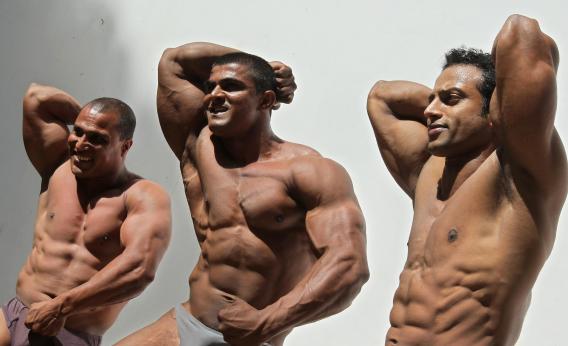A Brief History of Pec Popping

Photo by Manjunath Kiran/AFP/Getty Images
In a scene from the upcoming kid-friendly adventure-fantasy movie Journey 2: The Mysterious Island, pro-wrestler-turned-comic-actor Dwayne Johnson gives Josh Hutcherson a lesson in attracting women. Johnson puts his hand on Hutcherson’s shoulder, gives him a stern look, and says, “You have got to do this.”
Then he begins undulating his sizable pectoral muscles underneath his tight gray t-shirt.
“What is that?” asks Hutcherson, repulsed and intrigued by his mentor’s advice. “The pec pop of love,” Johnson says.
Two obvious questions arise from this exchange. The first is whether Dwayne Johnson needs a new agent. The second is when pec popping became a thing—and how it has turned into a Hollywood punch line.
The pec pop is a form of muscle control, the practice of flexing individual muscles independently of their surrounding muscles. Muscle control has likely existed for as long as men have tried to increase their strength through physical exercise, but it wasn’t until the rise of vaudeville in the late 19th century that it became a form of entertainment we would more or less recognize today. Many vaudeville shows included so-called strongmen, who would perform feats of strength and display their considerable musculature. According to David Chapman, the author of American Hunks: The Muscular Male Body in Popular Culture, 1860-1970 (among other books on the subject), “It was said … that professional strongman Eugene Sandow could make his muscles twitch and flutter in time to music—and this was in the mid-1890s.” Below is an 1894 video showing Sandow performing his muscle control stunts; he doesn’t pop his pecs, but he does flutter his biceps for a few moments at the beginning:
Bodybuilding increased in popularity over the next several decades, laying the groundwork for pec popping to become a popular phenomenon. But that wouldn’t really take place until much later. How come? Because early bodybuilders didn’t use anabolic steroids, which entered the scene only in the late 1950s. “Starting in the 1970s steroids allowed men to pack on hitherto impossibly large chest development,” Chapman explained in an email, “and that’s when ‘pec-popping’ increased in popularity.” Though officially banned by the International Federation of Bodybuilding and Fitness, synthetic testosterone was legal in the 1970s and popular among bodybuilding’s so-called “mass monsters.” Consider the exceptionally jacked competitors in the 1972 Mr. Olympia competition, including future California governor Arnold Schwarzenegger, isolating and flexing their pecs in the video below:
Inevitably, bodybuilding’s higher profile—aided by the 1977 Schwarzenegger documentary Pumping Iron and by Schwarzenegger’s burgeoning film career in the 1980s—invited caricature. “Pumping Up with Hans and Franz,” a Saturday Night Live feature that premiered during the 1987 season, sent up Schwarzenegger’s accent, heft, and perceived meatheadedness. In the recurring sketch, Kevin Nealon and Dana Carvey (padded with enormous fake muscles) promised to show their “girly man” viewers how to get buff, flexed their bodies with great effort, and flicked switches beneath their gray sweatsuits to create a comical pec-popping effect. In this installment from the early ’90s, the real Schwarzenegger—foreshadowing Dwayne Johnson’s own penchant for self-parody—joins Hans and Franz to teach a group of schoolchildren how to get fit. The pec popping, both real and simulated, begins around 4:13:
Around the same time that Nealon and Carvey were sending up bodybuilders, professional wrestling was entering a golden age during which the World Wrestling Federation and World Championship Wrestling competed for television viewers with equal portions of violence and theatricality. The wrestler-performers in these rival “leagues” often used pec popping to intimidate their opponents and display their physical prowess.
The WWF is where Johnson, formerly The Rock, got his start. And perhaps it’s no surprise that he’s morphed into a fairly successful actor known for his deft comic timing. After all, professional wrestling, like bodybuilding—and much vaudeville performance, for that matter—blurs the lines between athleticism, entertainment, and absurdity. Still, pec popping’s comical aspect shouldn’t obscure the real physical challenge involved. As Chapman explains, the practice provides “proof that one can concentrate one’s force in a single muscle or set of muscles … it is a very difficult skill to master, and it is exhausting to perform.”

